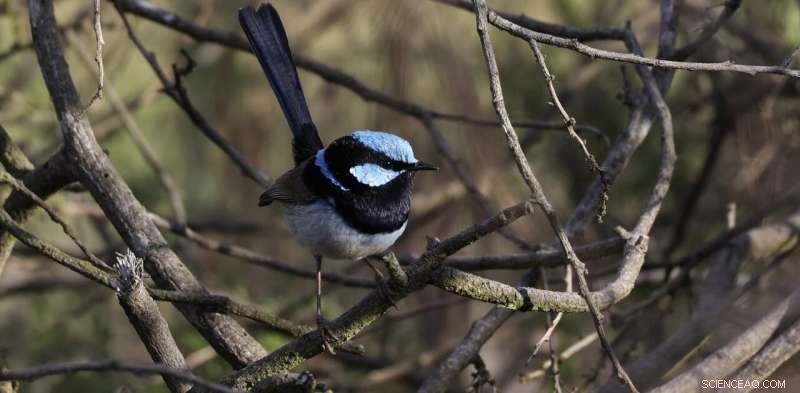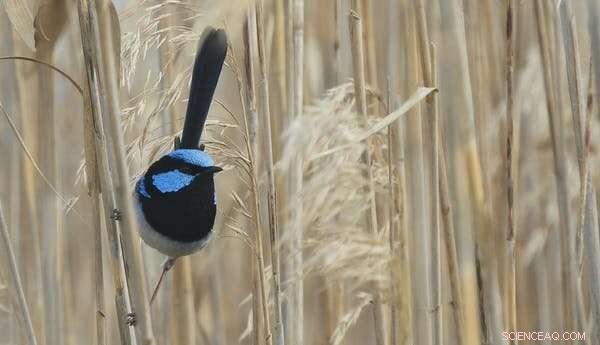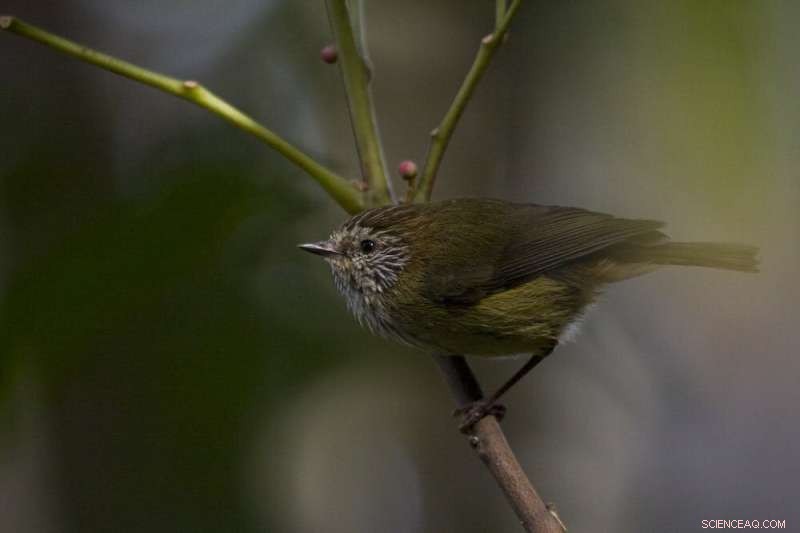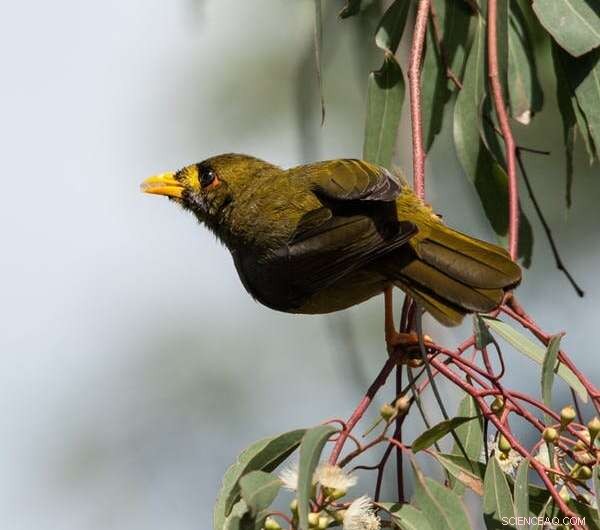Por que as soberbas sociedades carriças-fadas podem ser tão complexas quanto a nossa

Crédito:Kaspar Delhey, Autor fornecido
Um mistério que muitos biólogos querem resolver é como a complexidade se desenvolve na natureza. E entre os muitos sistemas sociais do mundo natural, as sociedades multiníveis se destacam por sua complexidade. Os indivíduos primeiro se organizam em famílias, que são membros de bandos, que são organizados em clãs.
Em cada nível, as associações entre os componentes (indivíduos, famílias e clãs) são estruturadas e estáveis. Em outras palavras, os indivíduos dentro das famílias geralmente ficam juntos, e as famílias geralmente interagem com outras famílias específicas de maneira previsível, para formar clãs estáveis.
Essa organização social provavelmente caracterizou grande parte da evolução humana (e ainda é comum entre muitas sociedades de caçadores-coletores ao redor do mundo).
De fato, sociedades multiníveis provavelmente desempenharam um papel fundamental na história humana, acelerando nossa evolução cultural. A organização em grupos sociais distintos teria reduzido a transmissão de culturas e permitido a coexistência de múltiplas tradições.
Em nossa pesquisa, publicada hoje na Ecology Letters, estudamos comportamentos sociais em uma população selvagem de soberbas carriças-de-fada. Descobrimos que essas aves também se organizam em sociedades de vários níveis – um nível de complexidade que se pensava ser exclusivo de mamíferos de cérebro grande.
Criação cooperativa de aves Embora tenhamos ideias sobre as vantagens das sociedades multiníveis, sabemos relativamente pouco sobre como e por que elas se formam.

As soberbas fada-wrens masculinas são notáveis devido à sua brilhante plumagem azul de reprodução.
Das poucas espécies conhecidas por viver em sociedades multiníveis, há uma característica compartilhada entre todas. Ou seja, vivem em grupos estáveis, em ambientes onde a disponibilidade de alimentos é inconsistente e difícil de prever.
Isso também é verdade para muitos pássaros que se reproduzem cooperativamente, incluindo a soberba carriça-fada – familiar nos parques e jardins do sudeste da Austrália. Eles se reproduzem em pequenos grupos familiares, com ajudantes não reprodutores auxiliando um casal reprodutor dominante. E esse sistema social é comum entre as espécies de aves australianas.
A soberba carriça-das-fadas é uma espécie bem estudada e é amada pelos australianos, sendo até coroada a ave do ano na enquete Guardian/BirdLife Australia deste ano.
Essas aves são notórias por sua abordagem poliamorosa ao sexo, apesar de serem socialmente monogâmicas. Os pares reprodutores formam laços sociais exclusivos, mas cada parceiro ainda acasala com outros indivíduos.
Our work now reveals this complex arrangement during the breeding season is just the tip of the iceberg.
Associating by choice We tracked almost 200 birds over two years, by attaching different-colored leg bands to each individual. We recorded the birds' social associations and, from our observations, built a complex social network that let us determine the strength of each relationship.

Striated thornbills form larger flocks outside of breeding season. Credit:Kaspar Delhey
We found that during the autumn and winter months, some breeding groups – (which include the breeding pair, one or more helpers and last summer's offspring), stably associated with other breeding groups to form supergroups. And this was usually done with individuals they were genetically related with.
In turn, these supergroups associated with other supergroups and breeding groups on a daily basis, forming large communities. In the following spring, these communities split back into the original breeding groups inhabiting well-defined territories—only to join again next winter.
Just like humans, these little birds don't associate with each other randomly during the long winter months. They have specific individuals and/or groups they choose to be with (but we're currently not sure how they make this choice).
While it's not yet clear why superb fairy-wrens form upper social units (supergroups and communities), we suspect this might allow individuals to exploit larger areas during winter, when food is scarce. It would also provide additional safety against predators, such as hawks and kookaburras.
This theory is supported by our literature study, which shows that multilevel societies are likely common among other Australian cooperatively breeding birds, such as the noisy and bell miners and striated thornbills.
Cooperative breeding is another strategy to deal with harsh condition such as food scarcity. So the conditions that favor cooperative breeding are the same as those that favor multilevel societies.

The bell miner is endemic to south-eastern Australia. Credit:Kaspar Delhey
Multilevel societies in other animals There are several other species which seem to have a similar social organization. They include primates such as baboons, and other large mammals that exhibit rich animal cultures, such as killer whales, sperm whales and elephants.
For a long time, researchers thought living in complex societies might be how humans evolved large brains. They also thought this characteristic may be exclusive to mammals with large brains, since keeping track of many different social relationships is not easy (or so the reasoning went).
Consequently, other animals with whom we are less closely related have mostly been excluded from this field of investigation.
This might reflect a bias that we, humans, have towards our own species and species which are similar to us.
As it turns, you don't need to be a mammal with a big brain to evolve complex multilevel societies. Even small-brained birds such as the tiny superb fairy-wren can do this—as well as the vulturine guineafowl a chicken-like bird from northeast Africa.
We strongly suspect quite a few birds will join their ranks in the coming years as more research is done.



